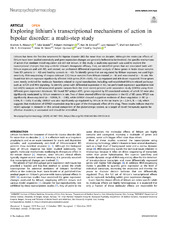| dc.contributor.author | Akkouh, Ibrahim | en_US |
| dc.contributor.author | Skrede, Silje | en_US |
| dc.contributor.author | Holmgren, Asbjørn | en_US |
| dc.contributor.author | Ersland, Kari Merete | en_US |
| dc.contributor.author | Hansson, Lars Johan Axel | en_US |
| dc.contributor.author | Bahrami, Shahram | en_US |
| dc.contributor.author | Andreassen, Ole Andreas | en_US |
| dc.contributor.author | Steen, Vidar Martin | en_US |
| dc.contributor.author | Djurovic, Srdjan | en_US |
| dc.contributor.author | Hughes, Timothy | en_US |
| dc.date.accessioned | 2020-07-01T13:02:13Z | |
| dc.date.available | 2020-07-01T13:02:13Z | |
| dc.date.issued | 2019 | |
| dc.Published | Akkouh I, Skrede S, Holmgren A, Ersland KM, Hansson LJA, Bahrami S, Andreassen OA, Steen VM, Djurovic S, Hughes T. Exploring lithium's transcriptional mechanisms of action in bipolar disorder: a multi-step study. Neuropsychopharmacology. 2019;45:947–955 | eng |
| dc.identifier.issn | 0893-133X | |
| dc.identifier.issn | 1740-634X | |
| dc.identifier.uri | https://hdl.handle.net/1956/23174 | |
| dc.description.abstract | Lithium has been the first-line treatment for bipolar disorder (BD) for more than six decades. Although the molecular effects of lithium have been studied extensively and gene expression changes are generally believed to be involved, the specific mechanisms of action that mediate mood regulation are still not known. In this study, a multi-step approach was used to explore the transcriptional changes that may underlie lithium’s therapeutic efficacy. First, we identified genes that are associated both with lithium exposure and with BD, and second, we performed differential expression analysis of these genes in brain tissue samples from BD patients (n = 42) and healthy controls (n = 42). To identify genes that are regulated by lithium exposure, we used high-sensitivity RNA-sequencing of corpus callosum (CC) tissue samples from lithium-treated (n = 8) and non-treated (n = 9) rats. We found that lithium exposure significantly affected 1108 genes (FDR < 0.05), 702 up-regulated and 406 down-regulated. These genes were mostly enriched for molecular functions related to signal transduction, including well-established lithium-related pathways such as mTOR and Wnt signaling. To identify genes with differential expression in BD, we performed expression quantitative trait loci (eQTL) analysis on BD-associated genetic variants from the most recent genome-wide association study (GWAS) using three different gene expression databases. We found 307 unique eQTL genes regulated by BD-associated variants, of which 12 were also significantly modulated by lithium treatment in rats. Two of these showed differential expression in the CC of BD cases: RPS23 was significantly down-regulated (p = 0.0036, fc = 0.80), while GRIN2A showed suggestive evidence of down-regulation in BD (p = 0.056, fc = 0.65). Crucially, GRIN2A was also significantly up-regulated by lithium in the rat brains (p = 2.2e-5, fc = 1.6), which suggests that modulation of GRIN2A expression may be a part of the therapeutic effect of the drug. These results indicate that the recent upsurge in research on this central component of the glutamatergic system, as a target of novel therapeutic agents for affective disorders, is warranted and should be intensified. | en_US |
| dc.language.iso | eng | eng |
| dc.publisher | Nature | eng |
| dc.rights | Attribution CC BY | eng |
| dc.rights.uri | http://creativecommons.org/licenses/by/4.0 | eng |
| dc.title | Exploring lithium's transcriptional mechanisms of action in bipolar disorder: a multi-step study | en_US |
| dc.type | Peer reviewed | |
| dc.type | Journal article | |
| dc.date.updated | 2020-01-14T08:44:33Z | |
| dc.description.version | publishedVersion | en_US |
| dc.rights.holder | Copyright 2019 The Author(s) | |
| dc.identifier.doi | https://doi.org/10.1038/s41386-019-0556-8 | |
| dc.identifier.cristin | 1760905 | |
| dc.source.journal | Neuropsychopharmacology | |

